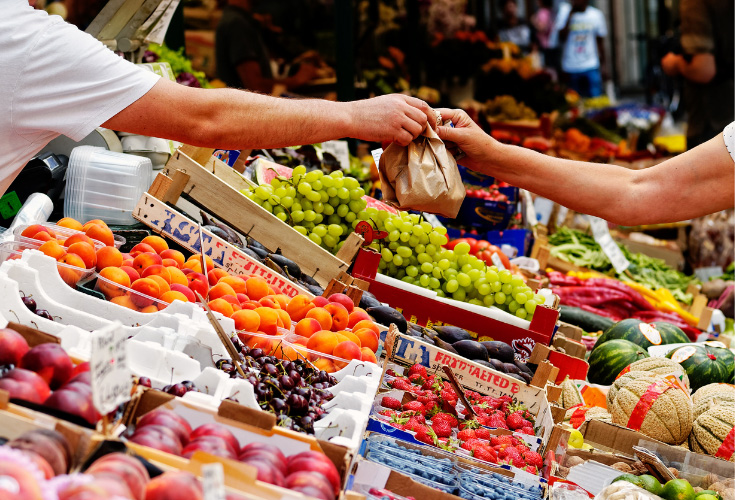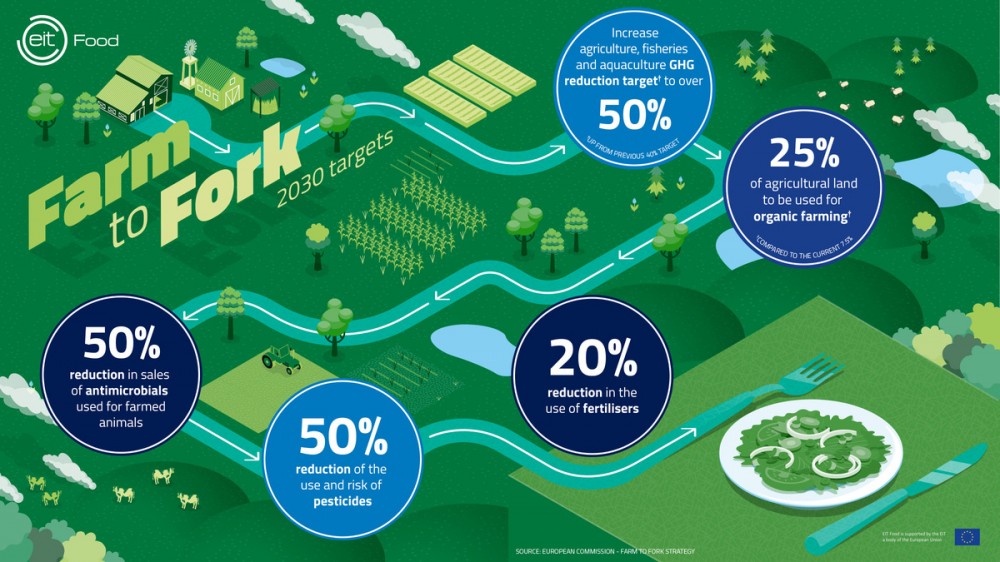What is the role of the Farm to Fork Strategy in achieving zero emissions?
As part of the European Green Deal, the Farm to Fork Strategy sets out a vision to change the way Europeans value food sustainability and to position Europe as the first climate neutral continent by 2050.

The COVID-19 pandemic has accelerated the drive for a zero emissions future as the world looks for ways to bounce back greener and cleaner. Research by economists and health experts is exploring how a ‘green recovery’ could not only benefit the climate but also human health and wellbeing (1), with the transformation of the food system a central focus point.
The food system remains one of the primary drivers of climate change and environmental degradation, and the EU is seeking solutions to reduce these impacts.
In 2017, the percentage contribution of CO2 equivalent (CO2eq) - a metric measure used to compare emissions from different greenhouse gases (GHG) - from agriculture was 20% of all human activities (2), including 11% from crop and livestock activities and 9% from associated land use (2). This is compared to worldwide industrial processes, such as cement production, which only accounted for 8% (2).
On top of this, approximately a third of food produced is wasted (3) either at the harvest level or the consumer and retail level. This is responsible for about 8% of global GHG emissions and nearly 30% of the world’s agricultural land is occupied to produce food that is ultimately never consumed (3). So, the challenge of finding solutions that reduce food loss and waste while not increasing emissions associated with production is in question.
"The way we can contribute to fighting climate change is by avoiding food loss and waste, making the food system more circular and by promoting a dietary shift.”
The goals of the Farm to Fork Strategy
The goal of the Farm to Fork strategy is to reduce these figures, ensuring that the food system has a neutral or positive impact on the environment without sacrificing its resiliency, productivity or safety.
EU Farm to Fork Strategy: European Commission
The Farm to Fork strategy addresses four key areas of supply chain management in the food industry: production, practices, consumption, and waste. Within this, it presents ideas on how we will need to work together to achieve better management of the four key topics, such as how future diets will need to change, and how mandatory labelling could become the norm where front-of-pack nutritional information as well as origin indication are required.

One challenge – perhaps the most pressing – is ensuring that the transition is fair and does not leave anyone behind. With 65% of low-income working adults across the world relying on agriculture to make money (5), and with crop yields already threatened by climate change, the strategy seeks a balance to secure a food system that preserves jobs, livelihoods and traditions along the way.
The strategy has set out to make the most sustainable, healthiest food also the most affordable. It strives to make sustainability and zero emissions a ‘trademark’ for businesses and a go-to choice for consumers.
Farmers, fishers, entrepreneurs and other food supply chain players who actively engage with the transition process will be rewarded. For instance, farming practices that remove CO2 from the atmosphere will be rewarded via the common agricultural policy (CAP) (6) or other similar initiatives. Through the CAP, farmers will receive subsidies for protecting land, water, air, plants and wildlife as well as for tackling climate change.
A new organic legislation will also be implemented in 2022 (7) which aims to make it easier for conventional farmers to transition to regenerative agriculture. This hopes to see organic produce become more readily available, all while reducing the use of harmful pesticides, reducing emissions from agriculture, decreasing the rates of soil erosion and increasing biodiversity.
Regenerative farming also seeks to increase the organic matter in soil, which makes it better able to absorb carbon from the atmosphere, meaning it has the potential to reduce climate change instead of contributing to it. In fact, soil scientist and winner of the 2020 World Food Prize, Dr Rattan Lal, claims that increasing the carbon content of the world’s soil by just 2% would entirely return GHG in the atmosphere to safe levels.
“One of the main goals of regenerative agriculture is carbon sequestration. If regenerative practices are applied globally, we can considerably reduce carbon in the atmosphere. Regenerative agriculture test farms such as David Brandt’s in Carrol, Ohio have shown that you can go from poor soils containing less than 1% carbon to 4% carbon content in a matter of six years, so it is doable. But to have a true impact on climate, regenerative agriculture needs to be implemented on a global scale.”
Citizens and stakeholders have been invited to engage in debate about how the European food system needs to change and the Farm to Fork strategy will be reviewed by mid-2023. Find out more here.
Is the Farm to Fork Strategy achievable?
The Farm to Fork Strategy has clearly set out an ambitious vision for the food sector. Under Horizon 2020, the European Commission has proposed €10 billion for research and innovation on food to help ease Europe into the transition to a more sustainable food system.
Naturally, however, policies and best practice will differ from nation to nation and there is no ‘one size fits all’ solution for any food supply chain. The strategy lays out plans to develop strategic roadmaps specific for member states, and the Commission has committed to pursue the development of international alliances to address any unique challenges experienced in different parts of Europe and the world.
The EU set a target to reduce GHG emissions by 20% compared to 1990 levels by 2020. In 2018, it recorded a 23% reduction (8) and the EU as a whole is expected to overachieve its 2020 target and to remain well below the set limits.
However, despite this overall reduction, some countries such as Malta, Germany, Ireland and Austria may end up with levels of emissions higher than their limits (8). Also, agricultural emissions have remained virtually unchanged in other countries, such as in the UK (9), for over a decade.
In fact, 44% of farmers in the UK took no action to reduce GHG emissions in 2017, and half of farmers reported that they did not think it was important to consider emissions when making decisions about farming practices (9). This highlights the importance of education in driving positive change.
“Changing the way you farm is difficult, especially if it questions what your neighbours and the entire agrifood industry have been doing for the past 70 years. And if that wasn’t enough of a challenge, farmers often find that they must fight against a complex maze of legislation that discourages many regenerative agriculture practices.”
EIT Food is working with leading higher education institutions and food companies to offer programmes that include information about improving your own sustainability credentials, as well as ways to grow your food business and career. Find out more here.
How is EIT Food helping the transition to a sustainable food system?
Although some aspects of the food system have already started to contribute positively to the transition to zero emissions, there is still a long way to go and it will not change overnight.
Additionally, 33 million people in the EU still can’t afford enough nutritious food to constitute a healthy diet (10) and obesity is on the rise. This needs to change and the time is now.
With the mission of building a sustainable, consumer-centric food system, our work is driving change and supporting this transition. EIT Food supports agrifood startups, entrepreneurs and visionaries who are all looking for the answers to these questions. So, how can we transform the food system quickly, sustainably and fairly?
By sharing knowledge, expertise and experience, the EIT Food network connects stakeholders across the food system, enabling closer collaboration. One way in which we are doing this is with the EIT Food Accelerator Network (FAN) (11), which supports high-impact agrifood startups and food-tech startups that are looking to fast track their development.
“Our contribution to tackling climate change is by increasing the circularity of the food system, and reducing food loss and food waste. We also provide options to make people’s diets more ‘climate friendly’, i.e. options to replace animal based products (proteins) - which generally produce more GHG emissions - with more sustainable protein alternatives. This is why two of our focus areas are ‘Circular Food Systems’ and ‘Alternative Proteins.”
EIT Food, Queen’s University Belfast and the University of Turin are offering a free online course about the complexity of the global food supply chain and the future of agriculture. You can find out more and register here.
Further reading
- FoodUnfolded: EU Green Deal: 5 ways policy might impact our food system
- EIT Food: The Regenerative Agriculture Revolution
- FAO: Tackling climate change through livestock
- Reuters: Farming and eating need to change to curb global warning - UN report
- WWF: EU Commission plans green reset for nature, food and farming
Sources
- World Economic Forum: COVID-19: 5 ways to create a green recovery
- Food and Agricultural Organization of the United Nations: The Contribution of Agriculture to Greenhouse Gas Emissions
- United Nations: A new international day with difficult starting point
- Eurostat: Organic farming statistics
- The World Bank: Agriculture and food
- European Commission: The common agricultural policy at a glance
- European Commission: The future of organics
- European Commission: Progress made in cutting emissions
- Committee on Climate Change: Reducing UK emissions 2018 Progress Report to Parliament
- Eurostat: Inability to afford a meal with meat, chicken, fish (or vegetarian equivalent) every second day - EU-SILC survey
- EIT Food: EIT Food Accelerator Network programme: apply now
More blog posts

POWERED BY A PARENT’S LOVE

